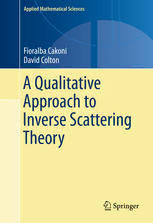Table Of ContentApplied Mathematical Sciences
Fioralba Cakoni
David Colton
A Qualitative
Approach to
Inverse Scattering
Theory
Applied Mathematical Sciences
Volume 188
FoundingEditors
FritzJohn,JosephLaselleandLawrenceSirovich
Editors
S.S.Antman
[email protected]
P.J.Holmes
[email protected]
K.R.Sreenivasan
[email protected]
Advisors
L.Greengard
J.Keener
R.V.Kohn
B.Matkowsky
R.Pego
C.Peskin
A.Singer
A.Stevens
A.Stuart
Forfurthervolumes:
http://www.springer.com/series/34
Fioralba Cakoni • David Colton
A Qualitative Approach
to Inverse Scattering Theory
123
FioralbaCakoni DavidColton
DepartmentofMathematicalSciences DepartmentofMathematicalSciences
UniversityofDelaware UniversityofDelaware
Newark,DE,USA Newark,DE,USA
ISSN0066-5452 ISSN2196-968X(electronic)
ISBN978-1-4614-8826-2 ISBN978-1-4614-8827-9(eBook)
DOI10.1007/978-1-4614-8827-9
SpringerNewYorkHeidelbergDordrechtLondon
LibraryofCongressControlNumber:2013950891
MathematicsSubjectClassification(2010):35P25,35R25,35R30,65M30,65R30,78A45
©SpringerScience+BusinessMediaNewYork2014
Thisworkissubjecttocopyright.AllrightsarereservedbythePublisher,whetherthewholeorpartof
thematerialisconcerned,specificallytherightsoftranslation,reprinting,reuseofillustrations,recitation,
broadcasting,reproductiononmicrofilmsorinanyotherphysicalway,andtransmissionorinformation
storageandretrieval,electronicadaptation,computersoftware,orbysimilarordissimilarmethodology
nowknownorhereafterdeveloped.Exemptedfromthislegalreservationarebriefexcerptsinconnection
withreviewsorscholarlyanalysisormaterialsuppliedspecificallyforthepurposeofbeingenteredand
executedonacomputersystem,forexclusiveusebythepurchaserofthework.Duplicationofthispub-
licationorpartsthereofispermittedonlyundertheprovisionsoftheCopyrightLawofthePublisher’s
location,initscurrentversion,andpermissionforusemustalwaysbeobtainedfromSpringer.Permis-
sionsforusemaybeobtainedthroughRightsLinkattheCopyrightClearanceCenter.Violationsareliable
toprosecutionundertherespectiveCopyrightLaw.
Theuseofgeneraldescriptivenames,registerednames,trademarks,servicemarks,etc.inthispublication
doesnotimply,evenintheabsenceofaspecificstatement,thatsuchnamesareexemptfromtherelevant
protectivelawsandregulationsandthereforefreeforgeneraluse.
Whiletheadviceandinformationinthisbookarebelievedtobetrueandaccurateatthedateofpublica-
tion,neithertheauthorsnortheeditorsnorthepublishercanacceptanylegalresponsibilityforanyerrors
oromissionsthatmaybemade.Thepublishermakesnowarranty,expressorimplied,withrespecttothe
materialcontainedherein.
Printedonacid-freepaper
SpringerispartofSpringerScience+BusinessMedia(www.springer.com)
To the Memory of
Natasha Colton
1975–2013
Preface
The field of inverse scattering theory has been a particularly active field in
applied mathematics for the past 25 years. The aim of research in this field
has been to not only detect but also to identify unknown objects through
the use of acoustic, electromagnetic, or elastic waves. Although the success
of such techniques as ultrasound and x-ray tomography in medical imaging
has been truly spectacular, progress has lagged in other areas of application,
which are forced to rely on different modalities using limited data in com-
plex environments. Indeed, as pointed out in [88] concerning the problem of
locating unexploded ordinance, “Target identification is the great unsolved
problem. We detect almost everything, we identify nothing.”
Until a few years ago, essentially all existing algorithms for target iden-
tification were based on either a weak scattering approximation or on the
use of nonlinear optimization techniques. A survey of the state of the art for
acoustic and electromagnetic wavesas of 1998can be found in [54]. However,
as the demands of imaging increased, it became clear that incorrect model
assumptions inherent in weak scattering approximations imposed severe lim-
itations onwhen reliable reconstructionswerepossible. On the otherhand, it
was also realized that for many practical applications nonlinear optimization
techniquesrequireaprioriinformationthatisingeneralnotavailable.Hence,
in recent years, alternative methods for imaging have been developed that
avoidincorrectmodel assumptions but, as opposedto nonlinear optimization
techniques, only seek limited information about the scattering object. Such
methods come under the general title of qualitative methods in inverse scat-
tering theory. Examples of such an approachare the linear sampling method,
[54,107], the factorization method [98,107], the method of singular sources
[138,139], the probe method [91,92], and the use of convex scattering sup-
ports[74,116],allofwhichseektodetermineanapproximationtotheshapeof
the scattering obstacle but in general provide only limited informationabout
the material properties of the scatterer.
This book is designed to be an introduction to qualitative methods in
inverse scattering theory, focusing on the basic ideas of the linear sampling
vii
viii Preface
methodandits closerelative,the factorizationmethod. The obviousquestion
is:anintroductionforwhom?Oneofthe problemsinmakingthesenew ideas
in inverse scattering theory available to the wider scientific and engineering
community is that the research papers in this area make use of mathemat-
ics that may be beyond the training of a reader who is not a professional
mathematician. This book represents an effort to overcome this problem and
to write a monograph that is accessible to anyone having a mathematical
background only in advanced calculus and linear algebra. In particular, the
necessary material on functional analysis, Sobolev spaces, and the theory of
ill-posed problems will be given in the first two chapters. Of course, to do
this in a short book such as this one, some proofs will not be given, nor will
all theorems be proven in complete generality. In particular, we will use the
mapping and discontinuity properties of double- and single-layer potentials
with densities in the Sobolev spaces H1/2(∂D) and H−1/2(∂D), respectively,
but will notprove any of these results, referring for their proofs to the mono-
graphs [111] and [127]. We will furthermore restrict ourselves to a simple
model problem, the scattering of time-harmonic electromagneticwaves by an
infinite cylinder. This choice means that we can avoid the technical difficul-
tiesofthree-dimensionalinversescatteringtheoryfordifferentmodalitiesand
insteadrestrictourattentiontothe simplercaseoftwo-dimensionalproblems
governedby the Helmholtz equation. For a glimpse ofthe problemsarisingin
the three-dimensional “real world,” we refer the reader to [26].
Although, for the foregoing reasons we do not discuss the qualitative ap-
proach to the inverse scattering problem for modalities other than electro-
magnetic waves, the reader should not assume that such approaches do not
exist! Indeed, having mastered the material in this book, the reader will be
fully preparedto understandthe literatureonqualitativemethods forinverse
scattering problems arising in other areas of application, such as acoustics
and elasticity. In particular, for qualitative methods in the inverse scattering
problem for acoustic waves and underwater sound see [12,133,158,159,160],
whereas for elasticity we refer the reader to [5,37,38,73,132,135,150].
We would like to acknowledge the scientific and financial support of the
Air Force Office of Scientific Researchandin particularDr. Arje Nachmanof
AFOSRandDr.RichardAlbaneseofBrooksAirForceBase.Finally,aspecial
thanks to our colleague Peter Monk, who has been a participant with us in
developing the qualitative approach to inverse scattering theory and whose
advice and insights have been indispensable to our researchefforts.
In closing, we note that this book is an updated and expanded version of
anearlierbook by the authorsthatoriginallyappearedinthe SpringerSeries
on Interactions of Mechanics and Mathematics entitled Qualitative Methods
in Inverse Scattering Theory.
Newark, Delaware Fioralba Cakoni, David Colton
Contents
1 Functional Analysis and Sobolev Spaces ................... 1
1.1 Normed Spaces.......................................... 1
1.2 Bounded Linear Operators................................ 6
1.3 Adjoint Operator........................................ 14
1.4 Sobolev Space Hp[0,2π] .................................. 17
1.5 Sobolev Space Hp(∂D)................................... 23
2 Ill-Posed Problems ........................................ 27
2.1 Regularization Methods .................................. 28
2.2 Singular Value Decomposition............................. 30
2.3 Tikhonov Regularization ................................. 36
3 Scattering by Imperfect Conductors ....................... 45
3.1 Maxwell’s Equations ..................................... 45
3.2 Bessel Functions......................................... 47
3.3 Direct Scattering Problem ................................ 51
4 Inverse Scattering Problems for Imperfect Conductors..... 63
4.1 Far-Field Patterns....................................... 64
4.2 Uniqueness Theorems for Inverse Problem .................. 67
4.3 Linear Sampling Method ................................. 72
4.4 Determination of Surface Impedance ....................... 78
4.5 Limited Aperture Data................................... 81
4.6 Near-Field Data......................................... 83
5 Scattering by Orthotropic Media .......................... 85
5.1 Maxwell Equations for an Orthotropic Medium.............. 85
5.2 Mathematical Formulation of Direct Scattering Problem...... 89
5.3 Variational Methods ..................................... 94
5.4 Solution of Direct Scattering Problem......................105
ix

